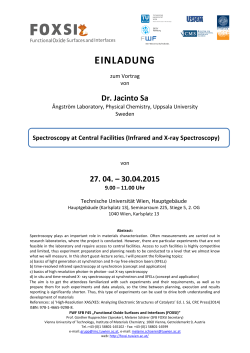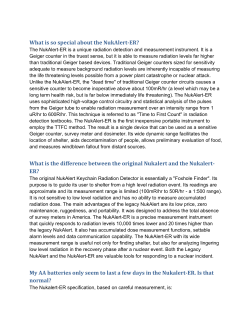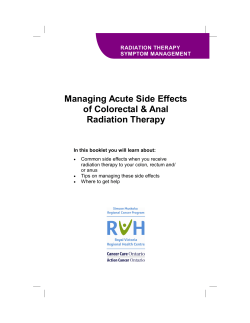
1/2/2014 U.V. Spectroscopy: What is Spectroscopy? Contd….
1/2/2014 U.V. Spectroscopy: Applications What is Spectroscopy? Perspective Dr. Poonam Piplani Professor (Pharm. Chemistry) University Institute of Pharmaceutical Sciences Panjab University, Chandigarh The Electromagnetic Spectrum • From the viewpoint of an organic chemist the 4 most frequently used spectroscopic investigations are: • Infrared (IR) spectroscopy measures the bond vibration frequencies in a molecule and is used to determine the functional groups. Mass spectrometry (MS) fragments the molecule and measures the masses. Nuclear magnetic resonance (NMR) spectroscopy in which source produces radiation in the radiofrequency region. Ultraviolet (UV) spectroscopy in which the instruments use a source which can produce radiation of wavelength between 200-800 nm. • n= c /l • The word spectroscopy implies the use of electromagnetic spectrum to gain information about organic molecules. • Ultraviolet spectroscopy incultates that the information will be obtained from a specific region of the electromagnetic spectrum called the ultraviolet region (190 to 400 nm U.V. Region and 400 to 800 nm Visible Region) . Ultraviolet spectroscopy Types of Spectroscopy • E = hn Contd…. • Sunlight is composed of many components which can be separated by passing through some medium (prism). Such a separation of the components constitutes the formation of a spectrum. This study of interaction of the components of light with matter is known as Spectroscopy. • • Ultraviolet radiation is the part of the electromagnetic spectrum which bridges the gap between the longest wavelength x-rays and shorter wavelength visible light. • This UV region is divided into into far UV (10- 200 nm) and near UV or quartz (200-380 nm) regions. Far UV radiation is absorbed by air because of the moisture and also because of electronic transitions in atmospheric O2, N2 and CO2. One must use vacuum apparatus to study far UV radiation. That is why this region is known vacuum region. • Quartz optics are therefore used to study in the near UV region. Glass absorbs UV radiation in this region. 5 Contd….. Contd….. • The total energy of the molecule is the sum total of its binding or electronic, vibrational and rotational energy. • Energy absorbed in the UV region produces changes in the electronic energy of the molecule resulting from the transitions of valency electrons in the molecule. • In the case of molecules, electronic transitions occur at the molecule orbital levels. Such transitions require the amount of energy possessed by the photons in the UV region and become the chief area of interest in UV spectroscopy. Electronic Transitions In the ground state both the e- are in the bonding orbital and have opposite spins whereas the antibonding * orbital is empty. When the molecule absorbs photons of correct energy, one of these e- is promoted to antibonding * molecular orbital. This state of the molecule is referred to as the excited state. Similar transitions can take place for s and n elctrons also. For radiation to cause electronic excitation it must be in the UV region of electromagnetic spectrum. 1 1/2/2014 The valence electrons are the only ones whose energies permit them to be excited by near UV/visible radiation. Characteristic groups may be recognized in the complex structures. Ultraviolet (UV) Spectroscopy – The Instrumentation s* (anti-bonding) * (anti-bonding) Four types of transitions * n (non-bonding) n* (bonding) The recorder assem bly The absorption results from the conjugated “enone enone”” portion of the two compounds. * n * s (bonding) s s* transition in vacuum UV n s* saturated compounds with non-bonding electrons n ~ 150-250 nm e ~ 100-3000 ( not strong) n *, * requires unsaturated functional groups (eq. double bonds) most commonly used, energy good range for UV/Vis n ~ 200 - 700 nm n * : e ~ 10-100 *: e ~ 1000 – 10,000 The spectrom eter itself – this houses the lam ps, m irrors, prism s and detector. The spectrom eter splits the beam of radiation into tw o and passes one through a sam ple and one through a reference solution (that is alw ays m ade up of the solvent in w hich you have dissolved the sam ple). The detector m easures the difference between the sam ple and reference readings and com m unicates this to the recorder. The sam ples are dissolved in a solvent w hich is transparent to UV light and put into sam ple cells called cuvettes. The cells them selves also have to be transparent to UV light and are accurately m ade in all dim ensions. They are norm ally designed to allow the radiation to pass through the 12 sam ple over a distance of 1cm . Double-beam UV Spectrophotometer U.V. Spectrum Applications of U.V. Spectroscopy: UV spectrum is a plot of absorption intensity (ordinate) versus wavelength (abscissa). The absorption intensity is plotted either as Є or log Є and is reported as Єmax meaning that this is the maximum molar extinction coefficient. The wavelength of absorption is usually expressed as λmax, meaning that this is the maximum absorption. 1. QUALITATIVE ANALYSIS UV absorption spectroscopy can characterize those types of compounds which absorbs UV radiation. Identification is done by comparing the absorption spectrum with the spectra of known compounds. Optical system of a double-beam spectrophotometer COMPARISON OF U.V. SPECTRA OF BENZENE WITH PHENOL U.V. SPECTRA OF PARACETAMOL (PCM) 2. Detection of Impurities UV absorption spectroscopy is one of the best methods for determination of impurities in organic molecules. Additional peaks can be observed due to impurities in the sample and it can be compared with that of standard raw material. By also measuring the absorbance at specific wavelength, the impurities can be detected. 2 1/2/2014 3. Structure elucidation of organic compounds. 4. QUANTITATIVE ANALYSIS UV absorption spectroscopy can be used for the quantitative determination of compounds that absorb UV radiation. This determination is based on Lambert Beer’s law which is as follows. UV spectroscopy is useful in the structure elucidation of 5. CHEMICAL KINETICS Kinetics of reaction can also be studied using UV spectroscopy. UV radiation is passed through the organic molecules, the presence or absence of unsaturation reaction cell and the absorbance changes can be and the presence of hetero atoms. observed. Where : I0 -Intensity of incident light From the location of peaks and combination of peaks, it can I -Intensity of transmitted light be concluded that whether the compound is saturated or ε -is extinction co-efficient, unsaturated, hetero atoms are present or not etc. c- is concentration, and b- is the length of the cell that is used in UV spectrophotometer. 7. QUANTITATIVE ANALYSIS OF PHARMACEUTICAL 8. EXAMINATION OF POLYNUCLEAR HYDROCARBONS SUBSTANCES Many drugs (raw material or formulation ) e.g. Diazepam, Chloramphenicol etc., can be assayed by NAPHTHALENE DIPHENYL Benzene and polynuclear hydrocarbons have characteristic spectra in ultraviolet and visible region. Thus identification of poly nuclear hydrocarbons making a suitable solution of the drug in a solvent and can be made by comparison with the spectra of known poly nuclear compounds. measuring the absorbance at a specific wavelength. Polynuclear hydrocarbons are the hydrocarbon molecules with two or more closed rings; examples are naphthalene, C10H8, with two benzene rings side by side, or diphenyl, (C6H5)2, with two bond-connected benzene rings. Also known as polycyclic hydrocarbon. 9. MOLECULAR WEIGHT DETERMINATION DERIVATIVE The concentration of the solution in gm moles per litre can be calculated by using the following formula. Molecular weight of compounds can be measured spectrophotometrically by preparing the suitable derivatives of SPECTROSCOPY It shows better resolution of the overlapping bands than fundame ntal spectrum and may pe rmit the actual dete rmination of the l max of the individual bands. In de rivative spectroscopy, DA/Dl is plotted against the wavelength. It is excellent for dete rmination of multi components in a sample, if they can be resolved. these compounds. For example, to determine the molecular weight of an amine it is converted to amine picrate. Then optical density of a known concentration of amine picrate solution is measured at λmax 380 nm. "c" can be calculated using above equation, the weight "w" of amine picrate is known. From "c" and "w", molecular weight of amine picrate can be calculated. 3 1/2/2014 SOLID STATE U.V. SPECTROSCOPY It is specifically designed to measure the reflectance or transmittance of solids, liquids, powders, or other small objects that can fit in the transmittance or reflectance ports. Loading a standard or sample into the sample holder. SOLID STATE U.V. SPECTROSCOPY: THE INSTRUMENTATION Basic components of the accessory include the integrating sphere, transfer optics and detector pre amplification module. Optical Setup APPLICATIONS Measuring reflectance of a solid sample. TACKLES DIFFICULT LIQUID SAMPLES WITH EASE • Turbid and cloudy liquids and suspensions, including DNA, proteins and blood are handled with ease, which can make highly accurate measurements up to 6 Absorbance units. • Choice of cell and autosamplers speed and simplify multi-sample analyses. Specular Diffuse Depending on the equipment used, it is possible to take separate measurements for specular reflectance, diffuse reflectance or overall reflectance. CONTD…… • A range of simple fixed and variable-angle solid sample holders allow transmittance measurements of materials such as glass, polymer films and filters. • A range of single and multiple-cell accessories ensures precise and rapid thermostatting for biological studies such as enzyme kinetics, DNA melt and general kinetics measurements in chemistry. • Huge choice of cells and sample holders allows virtually any liquid and solid sample to be measured. Options include longpath cells, test-tube holders, flow-through cells and micro and semi-micro cells • For relative and absolute reflectance measurements on mirrors, optics and thin-film coatings. Used in Paint industry to determine the quality of the paint. CONCLUSION To conclude, UV-Visible spectrometers have been in general use for the last 35 years and over this period have become the most important analytical instrument in the modern day laboratory. In many applications other techniques could be employed but none rival UVVisible spectrometry for its simplicity, versatility, speed, accuracy and costeffectiveness. 4
© Copyright 2025





















